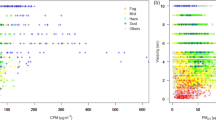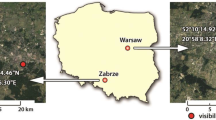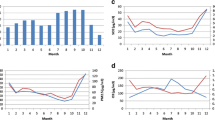Abstract
Aerosols in the atmosphere not only degrade visibility, but are also detrimental to human health and transportation. In order to develop a method to estimate PM2.5 mass concentration from the widely measured visibility, a field campaign was conducted in Southwest China in January 2019. Visibility, ambient relative humidity (RH), PM2.5 mass concentrations and scattering coefficients of dry particles were measured. During the campaign, two pollution episodes, i.e., from 4–9 January and from 10–16 January, were encountered. Each of the two episodes could be divided into two periods. High aerosol hygroscopicity was found during the first period, when RH was higher than 80% at most of the time, and sometimes even approached 100%. The second period experienced a relatively dry but more polluted condition and aerosol hygroscopicity was lower than that during the first period. An empirical relationship between PM2.5 mass concentration and visibility (ambient aerosol extinction) under different RH conditions could thus be established. Based on the empirical relationship, PM2.5 mass concentration could be well estimated from visibility and RH. This method will be useful for remote sensing of PM2.5 mass concentration.
摘 要
大气气溶胶不仅降低能见度, 也危害人体健康和交通运输. 基于 2019 年 1 月在西南地区外场观测中的能见度、 环境湿度、 PM2.5质量浓度和干气溶胶散射系数, 本文发展了一套利用能见度估算 PM2.5质量浓度的方法. 观测期间, 经历了两个污染过程 (1 月 4–9 日及 10–16 日), 每个过程都可以分为两个阶段: 第一阶段相对湿度大部分时间都高于 80%, 有时候接近 100%, 且气溶胶吸湿性较强; 第二阶段相对湿度相对较低, 污染更严重, 且气溶胶吸湿性弱于第一阶段. 基于外场观测数据, 本文建立了 PM2.5 质量浓度与能见度 (或环境气溶胶消光系数) 在不同相对湿度下的关系. 基于该关系, 可以利用能见度和相对湿度很好地估算 PM2.5 质量浓度. 该方法也可以用于改进 PM2.5 质量浓度的遥感反演。
Article PDF
Similar content being viewed by others
Avoid common mistakes on your manuscript.
References
Carrico, C. M., P. Kus, M. J. Rood, P. K. Quinn, and T. S. Bates, 2003: Mixtures of pollution, dust, sea salt, and volcanic aerosol during ACE-Asia: Radiative properties as a function of relative humidity. J. Geophys. Res., 108, 8650, https://doi.org/10.1029/2003JD003405.
Chan, C. K., and X. H. Yao, 2008: Air pollution in mega cities in China. Atmos. Environ., 42, 1–42, https://doi.org/10.1016/j.atmosenv.2007.09.003.
Chan, Y. C., R. W. Simpson, G. H. Mctainsh, P. D. Vowles, D. D. Cohen, and G. M. Bailey, 1999: Source apportionment of visibility degradation problems in Brisbane (Australia) using the multiple linear regression techniques. Atmos. Environ., 33, 3237–3250, https://doi.org/10.1016/S1352-2310(99)00091-6.
Chelani, A. B., 2019: Estimating PM2.5 concentration from satellite derived aerosol optical depth and meteorological variables using a combination model. Atmospheric Pollution Research, 10, 847–857, https://doi.org/10.1016/j.apr.2018.12.013.
Chen, J., and Coauthors, 2019: Aerosol hygroscopic growth, contributing factors, and impact on haze events in a severely polluted region in northern China. Atmospheric Chemistry and Physics, 19, 1327–1342, https://doi.org/10.5194/acp-19-1327-2019.
Collaud Coen, M., and Coauthors, 2010: Minimizing light absorption measurement artifacts of the Aethalometer: Evaluation of five correction algorithms. Atmospheric Measurement Techniques, 3, 457–474, https://doi.org/10.5194/amt-3-457-2010.
Ding, M. Z., A. L. Chen, and Y. S. Ni, 2014: Several observation methods of PM10, PM2.5. Journal of Zhejiang Meteorology, 35(4), 44–46, https://doi.org/10.16000/j.cnki.zjqx.2014.04.010. (in Chinese)
Gassó, S., and Coauthors, 2000: Influence of humidity on the aerosol scattering coefficient and its effect on the upwelling radiance during ACE-2. Tellus B, 52, 546–567, https://doi.org/10.3402/tellusb.v52i2.16657.
Hänel, G., 1976: The properties of atmospheric aerosol particles as functions of the relative humidity at thermodynamic equilibrium with the surrounding moist air. Advances in Geophysics, 19, 73–188, https://doi.org/10.1016/S0065-2687(08)60142-9.
Hänel, G., 1980: An attempt to interpret the humidity dependencies of the aerosol extinction and scattering coefficients. Atmos. Environ., 15, 403–406, https://doi.org/10.1016/0004-6981(81)90045-7.
Hansen, A. D. A., H. Rosen, and T. Novakov, 1984: The aethalometer—An instrument for the real-time measurement of optical absorption by aerosol particles. Science of the Total Environment, 36, 191–196, https://doi.org/10.1016/0048-9697(84)90265-1.
Kan, H. D., R. J. Chen, and S. L. Tong, 2012: Ambient air pollution, climate change, and population health in China. Environment International, 42, 10–19, https://doi.org/10.1016/j.envint.2011.03.003.
Kasten, F., 1969: Visibility forecast in the phase of pre-condensation. Tellus, 21, 631–635, https://doi.org/10.3402/tellusa.v21i5.10112.
Kotchenruther, R. A., and P. V. Hobbs, 1998: Humidification factors of aerosols from biomass burning in Brazil. J. Geophys. Res., 103, 32 081–32 089, https://doi.org/10.1029/98jd00340.
Li, C. C., X. He, Z. Z. Deng, A. K. H. Lau, and Y. Li, 2013: Dependence of mixed aerosol light scattering extinction on relative humidity in Beijing and Hong Kong. Atmos. Ocean. Sci. Lett., 6, 117–121, https://doi.org/10.1080/16742834.2013.11447066
Liu, F., Q. W. Tan, X. Jiang, F. M. Yang, and W. J. Jiang, 2019: Effects of relative humidity and PM2.5 chemical compositions on visibility impairment in Chengdu, China. Journal of Environmental Sciences, 86, 15–23, https://doi.org/10.1016/j.jes.2019.05.004.
Malm, W. C., and D. E. Day, 2001: Estimates of aerosol species scattering characteristics as a function of relative humidity. Atmos. Environ., 35, 2845–2860, https://doi.org/10.1016/s1352-2310(01)00077-2.
Müller, T., and Coauthors, 2011: Characterization and intercomparison of aerosol absorption photometers: Result of two intercomparison workshops. Atmospheric Measurement Techniques, 4, 245–268, https://doi.org/10.5194/amt-4-245-2011.
Pan, X. L., P. Yan, J. Tang, J. Z. Ma, Z. F. Wang, A. Gbaguidi, and Y. L. Sun, 2009: Observational study of influence of aerosol hygroscopic growth on scattering coefficient over rural area near Beijing mega-city. Atmospheric Chemistry and Physics, 9, 7519–7530, https://doi.org/10.5194/acp-9-7519-2009.
Pandolfi, M., and Coauthors, 2018: A European aerosol phenomenology-6: Scattering properties of atmospheric aerosol particles from 28 ACTRIS sites. Atmospheric Chemistry and Physics, 18, 7877–7911, https://doi.org/10.5194/acp-18-7877-2018.
Pui, D. Y. H., S. C. Chen, and Z. L. Zuo, 2014: PM2.5 in China: Measurements, sources, visibility and health effects, and mitigation. Particuology, 13, 1–26, https://doi.org/10.1016/j.partic.2013.11.001.
Ran, L., Z. Z. Deng, P. C. Wang, and X. A. Xia, 2016: Black carbon and wavelength-dependent aerosol absorption in the North China Plain based on two-year aethalometer measurements. Atmos. Environ., 142, 132–144, https://doi.org/10.1016/j.atmosenv.2016.07.014.
Ryan, P. A., D. Lowenthal, and N. Kumar, 2005: Improved light extinction reconstruction in interagency monitoring of protected visual environments. Journal of the Air & Waste Management Association, 55, 1751–1759, https://doi.org/10.1080/10473289.2005.10464768.
Song, M., S. Q. Han, M. Zhang, Q. Yao, and B. Zhu, 2013: Relationship between visibility and relative humidity, PM10, PM2.5 in Tianjin. Journal of Meteorology and Environment, 29, 34–41, https://doi.org/10.3969/j.issn.1673-503X.2013.02.006. (in Chinese)
Sun, J. Y., L. Zhang, X. J. Shen, H. C. Che, Y. M. Zhang, R. X. Fan, Q. L. Ma, Y. Yue, and X. M. Yu, 2016: A review of the effects of relative humidity on aerosol scattering properties. Acta Meteorologica Sinica, 74(5), 672–682. (in Chinese)
Sun, Y. B., Q. L. Zeng, B. Geng, X. W. Lin, B. Sude, and L. F. Chen, 2019: Deep learning architecture for estimating hourly ground-level PM2.5 using satellite remote sensing. IEEE Geoscience and Remote Sensing Letters, 16, 1343–1347, https://doi.org/10.1109/LGRS.2019.2900270.
van Donkelaar, A., R. V. Martin, and R. J. Park, 2006: Estimating ground-level PM2.5 using aerosol optical depth determined from satellite remote sensing. J. Geophys. Res., 111, D21201, https://doi.org/10.1029/2005JD006996.
Wang, Y. H., Z. R. Liu, J. K. Zhang, B. Hu, D. S. Ji, Y. C. Yu, and Y. S. Wang, 2015: Aerosol physicochemical properties and implications for visibility during an intense haze episode during winter in Beijing. Atmospheric Chemistry and Physics, 15, 3205–3215, https://doi.org/10.5194/acp-15-3205-2015.
Watson, J. G., 2002: Visibility: Science and regulation. Journal of the Air & Waste Management Association, 52, 628–713, https://doi.org/10.1080/10473289.2002.10470813.
Xu, L., 2017: The comparison research on determination of PM2.5 and PM10 concentration by light scattering method and β-ray method. Environment and Development, 29(6), 97–99, https://doi.org/10.16647/j.cnki.cn15-1369/X.2017.06.062. (in Chinese)
Zhang, R. H., Q. Li, and R. N. Zhang, 2014: Meteorological conditions for the persistent severe fog and haze event over eastern China in January 2013. Science China Earth Sciences, 57, 26–35, https://doi.org/10.1007/s11430-013-4774-3.
Zhao, C. S., Y. L. Yu, Y. Kuang, J. C. Tao, and G. Zhao, 2019: Recent progress of aerosol light-scattering enhancement factor studies in China. Adv. Atmos. Sci., 36, 1015–1026, https://doi.org/10.1007/s00376-019-8248-1.
Zheng, C., and Coauthors, 2017: Analysis of influential factors for the relationship between PM2.5 and AOD in Beijing. Atmospheric Chemistry and Physics, 17, 13 473–13 489, https://doi.org/10.5194/acp-17-13473-2017.
Zhou, M., and Coauthors, 2016: Chemical characteristics of fine particles and their impact on visibility impairment in Shanghai based on a 1-year period observation. Journal of Environmental Sciences, 48, 151–160, https://doi.org/10.1016/j.jes.2016.01.022.
Zieger, P., and Coauthors, 2011: Comparison of ambient aerosol extinction coefficients obtained from in-situ, MAX-DOAS and LIDAR measurements at Cabauw. Atmospheric Chemistry and Physics, 11, 2603–2624, https://doi.org/10.5194/acp-11-2603-2011.
Acknowledgements
This research was supported by a National Science and Technology Major Project (Grant No. 2016YFC 0200403) and the National Natural Science Foundation of China (Grant Nos. 41675037 and 41675038).
Author information
Authors and Affiliations
Corresponding author
Additional information
Article Highlights
• Aerosol hygroscopicity was found to decline during pollution episodes.
• An improved method for estimating PM2.5 mass concentration from visibility and RH was established.
Rights and permissions
Open Access This article is distributed under the terms of the Creative Commons Attribution 4.0 International License (http://creativecommons.org/licenses/by/4.0/), which permits unrestricted use, distribution, and reproduction in any medium, provided you give appropriate credit to the original author(s) and the source, provide a link to the Creative Commons license, and indicate if changes were made.
About this article
Cite this article
Ji, D., Deng, Z., Sun, X. et al. Estimation of PM2.5 Mass Concentration from Visibility. Adv. Atmos. Sci. 37, 671–678 (2020). https://doi.org/10.1007/s00376-020-0009-7
Received:
Revised:
Accepted:
Published:
Issue Date:
DOI: https://doi.org/10.1007/s00376-020-0009-7




